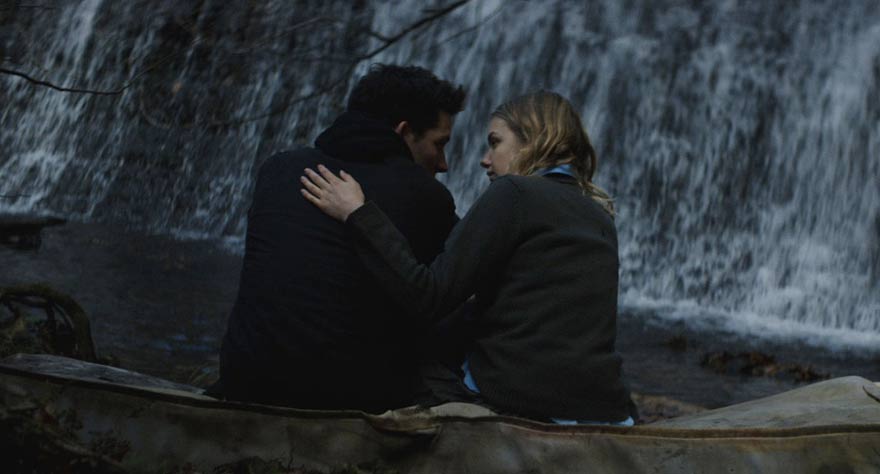
A disappointing perspective on a reality-inspired suicide pandemic that asks no questions and offers no answers.

A disappointing perspective on a reality-inspired suicide pandemic that asks no questions and offers no answers.
If suicide is a nonsensical act, leaving all in its wake confused and reeling, then Bridgend just might be its cinematic equivalent. Harsh, violent, and often lacking in reason, the film is a frustrating portrayal of fake people in a very real and very intriguing situation.
Based on real events and a real problem in the constantly wet and dreary Welsh county of Bridgend, where as of right now almost 80 teenagers have committed suicide since 2007. Which, rightly so, has induced rather a frenzy as adults scramble to figure out what’s happening with the youth of that area. First time director Jeppe Rønde’s film is set in this area, at an ambiguous point in the epidemic, but it is mentioned in the film the death count is around 23. The story is from the perspective of Sara (Game of Thrones’ Hannah Murray), who moves back to the Bridgend area with her father, Dave (Steven Waddington), after years away. Dave, a cop, has come to lead the investigation on the suicide problem. It seems a bit naïve of Dave not to worry about putting his teenage daughter into the middle of a teenage-suicide-centric town, but their bond is tight and at first she keeps herself distracted from the locals by her horseback riding and generally cheery attitude.
But she is after all a teenager, and when a local girl, Laurel, invites her to hang with the main group of teens in the small town, Sara can’t help herself. This group, led by the shaved-headed Thomas, like to hang out by a lake in the nearby woods. Often stripping down and jumping in, drinking beer and building bonfires. Typical rebellious teenage stuff and Sara is entranced by this tight-knit group. When they head back to town, they stop at the spot where the latest suicide took place, in their version of paying respect to their dead friend, they stop to howl the name of the deceased teen at the top of their lungs. Clearly these teens find more satisfaction in uniting and celebrating their friends’ deaths more than grieving or asking questions. Sara gets her first taste that this group may not be as typical as she thought. Hearing that Thomas, who had shown an interest in her, has committed suicide only a few days later—literally the day after Sara came on to him—feels like it ought to strike more fear into Sara’s heart, but strangely just seems to bring her closer to the other teens.
Throughout the film, the teens communicate in an online community. A chat group where they mourn the growing loss of their friends, while simultaneously extolling that each is in another place. That they are “together.” None of these teens seem especially concerned that their friends are dying. Sara, herself, doesn’t ask nearly enough questions of her new friends until much too late in the film. And her father, the cop, seems hell-bent on being insensitive and unhelpful in the investigation.
While it’s difficult to draw too many conclusions about a real-life case that is currently still open, the picture painted by Jeppe Rønde is one of a strange resignation. In the film the parents of these children, while distraught, don’t seem to be trying all that hard to understand what’s happening to their children. Nor does anyone try to keep a closer eye on the teens still living. The total lack of clear-thinking and logical interrogation is rather frustrating. Rønde chose to focus on the characters of the film rather than try to suggest possible answers for a real problem, but unfortunately the characters all feel two-dimensional.
Sara and her father, while close at first, quickly spiral when he starts seeing a local woman, who isn’t present enough to be a real character. And Sara is so utterly transfixed by Jamie (Josh O’Connor, giving the best performance of any of them), the new leader of the group after Thomas’s death, and the others that it’s hard to see her as the “strong” person others in the film keep claiming she is. The few parents who do pop up, also seem motivated and blinded to reality in an inexplicable way.
All of this could have played into the film if Rønde had offered up some sort of suggestion for what exactly is influencing them all. Supernatural? Old-fashioned bad parenting? It’s quite hard to tell what we’re supposed to think. The film builds, somewhat jarringly, to a dramatic climax. The film’s deafening and uncomfortable music pulsing in a way that makes the confusion of what is happening on screen that much more annoying. If we’re supposed to be frightened, Rønde could have at least given us a hint at what we’re supposed to be frightened of.
Much of the imagery used, the teens floating naked in the dirty lake for instance, feels distinctly horror-ish, but it’s hard to feel any real sense of dread. This may be due to the true-story aspects of the film and the very real mystery they present. For a film that couldn’t provide any real answers, it doesn’t seem to want to try to provide any real guesses. The lack of questions make it a puzzling and disturbing film that feels off-putting because it’s using a real and tragic scenario. The phenomena of cluster suicide is a strange and mystifying one, but it is a psychological phenomena and therefore should have been treated with a bit more mindful consideration.